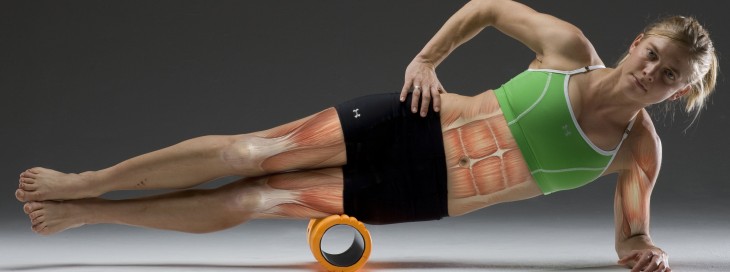
Rock ‘n’ Roll!
Bumpy Nubs and Studded Batons
By now I’m sure all of you have heard of foam rollers and probably even used one yourself but before they hit mainstream they were actually a favorite among professional athletes and I have been using for years to prevent injuries and alleviate pain. Recently since there has been such an appeal to them, they are now a bit more sophisticated foam rollers of all shapes, sizes, and textures (spiked or nubby)-and they all offer even greater benefits for people who now know how to select the right one and use them properly for targeted self-massage.
By now we all know that foam rolling can help reduce muscle tightness, reduce exercise-induced soreness, and even prevent injuries by warming up muscles before you workout and even improve range of motion. Foam rolling is also helpful for variety of other common conditions especially tendinitis (this could be the patellar tendinitis of the knee or Achilles tendinitis of the ankle) or even other imbalances due to overuse such as tennis elbow or golfer’s elbow.
Why does this work so well you might ask… Well, in a nutshell, moving your body (or body part) back-and-forth across a foam roller increases restorative blood flow that helps promote connective tissue healing as well as releases lactic acid and other toxins built up during exercise or even the lack there of.
As you might have noticed walking through the aisles of many stores or venturing online, they are all different types of rollers out there now. Anything from spiked, to nubby, to baton shaped, and ball shaped has probably got you wondering which type is the best for you. Well … There is actually nothing more wonderful or not about any of those types. The main thing you should be concerned about is which one do you like the best. If one feels better than the other when you use it, then that’s the foam roller for you.
Now how do you use them and where do you use them?
Hamstrings -
As silly as it sounds tight hamstrings are common problem for people who sit long hours like at a desk or behind the wheel of the car but also for people who exercise regularly especially those who run or bike. And tight hamstrings are often one of the leading causes of lower back pain. (See my earlier article on back stretches). And because the hamstrings tend to be less sensitive than other muscles in your body the increased stimulation provided by textured roller (as opposed to a smooth roller) often works well.
How To Do It – Sit on the floor with your legs extended in front of you and your knees slightly bent, place the textured roller directly underneath your hamstrings perpendicular to the muscles and leg. While using your arms to support your weight, slowly move your body, rolling your hamstrings up and down the roller from the glutes to the knees and back-and-forth again. You can add or release weight by using your arms for control. When you reach a trigger point, you can either move back-and-forth over it for about 30 seconds or you can hold it steady until the knot “releases”. Although this might be painful at first, this technique is very very helpful and will pretty much make the pain melt away. This technique can also be used on pretty much any other part of the body as well.
Quads and Hip Flexors -
Walkers and runners and people with tendinitis in the knee (and yes, people that sit a lot) often have tight hip flexors. Anyone who sits a lot especially needs to stretch and roll the quadriceps (front of the thighs) and hip flexors. It seems that baton style (the type of foam rollers with handles on either side) seem to be ideal for rolling out the quads or anytime you want better control of the pressure in intensity of the rolling. (This is opposed to lying on top of the roller and applying your own bodyweight.). For this reason I like baton rollers, especially for people who are sensitive the pain. And you can even have someone do it for you if you like (if you can find them. Ha)
Again, the best way is to sit on the floor with your legs extended in front of you. If you’d like some stability you can lean against something like a couch or wall or put a towel at the base of your buttocks. Bend your right leg slightly with your knee falling out to the side (this relaxes your hips) and position the baton on the top of your left leg, perpendicular to your thigh. Roll down in a way to just above the left knee as if you’re rolling out dough with a rolling pen then lift up return the top of the leg and repeat. It seems to work better going just the one direction away from the thigh and towards the knee than going back-and-forth (up and down).
Both of these should probably sound similar in principal as you could also use a baton roller for your hamstrings and a foam roller for your quads if need be.
Back and Shoulders -
The third place on the body that benefits the most from massagers is the back and shoulders. For this area, ball-shaped massagers seem to work well because the knots in these areas are hard to reach. These massagers with a ball are exactly what they sound like, anything from a golf ball to softball sized ball with two strings as handles that make it easier to get when the areas are in your upper or lower back, between the shoulder blades are in even the piriformis in the upper glutes. They can be a little hard to find but are worth it if you are willing to spend a little extra time picking out the right one for you.
To use it for tightness or pain in your upper back, or any other area, stand with your back against the wall and place the ball in the space between your shoulder blades (or the troubled area). You can bend your knees slightly and push your body weight into the ball by making small circles with the ball against the aggravated area. Be sure to avoid letting the ball directly press on your spine which could be painful/harmful. You can also use mini rollers or even large-scale foam rollers against the ground while lying on your back and/or shoulder blades.
These three types of rollers I’ve mentioned all have their advantages over the other but can all be substituted for each other by simply manipulating the body and creating pressure between the roller and the aggravated area.
Happy Rolling!

 Hire Us on Thumbtack
Hire Us on Thumbtack

